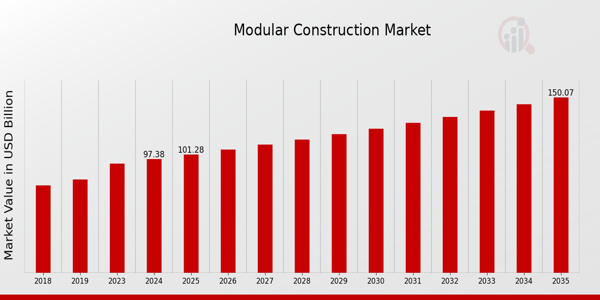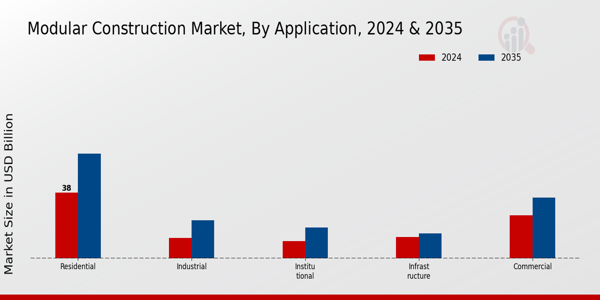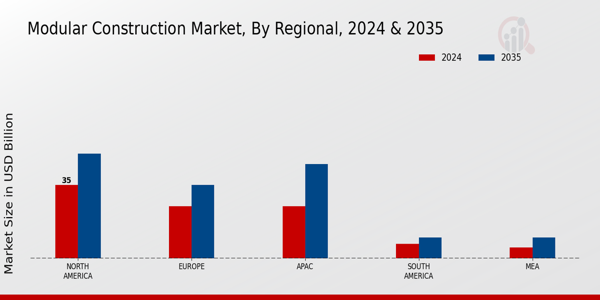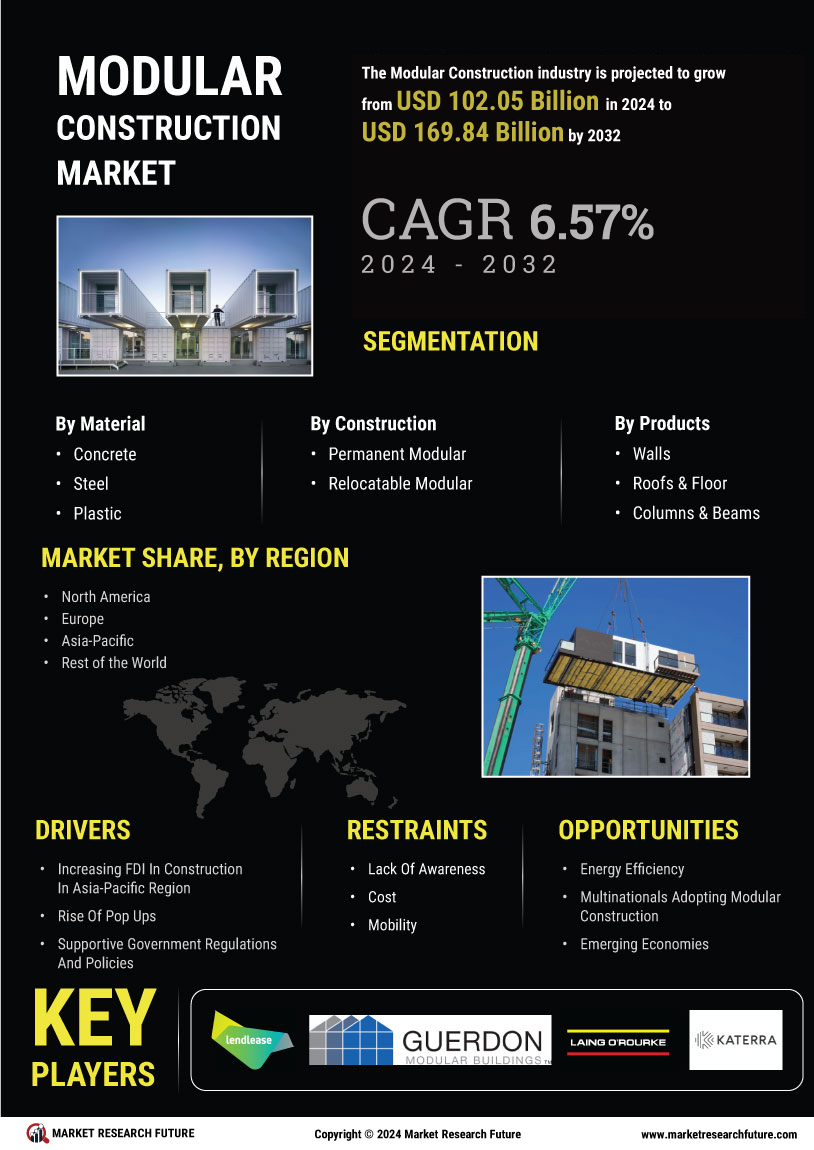Modular Construction Market Summary
As per Market Research Future Analysis, the Global Modular Construction Market is experiencing significant growth, with a market size of 93.62 USD Billion in 2023. The market is projected to grow to 150 USD Billion by 2035, driven by increasing demand for sustainable building solutions and government initiatives supporting infrastructure development.
Key Market Trends & Highlights
Key trends driving the modular construction market include sustainability, technological advancements, and regulatory support.
- The market is expected to grow from 97.38 USD Billion in 2024 to 150 USD Billion by 2035, with a CAGR of 4.01% from 2025 to 2035.
- The Residential application is projected to increase from 38.0 USD Billion in 2024 to 60.5 USD Billion by 2035.
- North America leads the market with a valuation of 35.0 USD Billion in 2024, expected to reach 50.0 USD Billion by 2035.
- Technological advancements can reduce construction time by up to 50%, enhancing efficiency in modular building processes.
Market Size & Forecast
2023 Market Size: USD 93.62 Billion
2024 Market Size: USD 97.38 Billion
2035 Market Size: USD 150.0 Billion
CAGR (2025-2035): 4.01%
Largest Regional Market Share in 2024: North America.
Major Players
Key players include Bouygues Construction, Viglucci Construction, Premier Modular, Z Modular, Plant Prefab, Modular Space Corporation, Kiewit Corporation, Swire Properties, Naylor Love Construction, North Sky Capital, Red Sea Housing Services, Lendlease Group, Balfour Beatty, Skanska AB, and Turner Construction Company.
Key Modular Construction Market Trends Highlighted
The demand for sustainability and efficiency in building methods is driving notable changes in the global modular construction market. The growing need for quick building techniques is a major market driver, particularly in cities where space is scarce and housing shortages are common.
Modular building is becoming more and more accepted by governments as a practical way to satisfy these needs and advance infrastructure development. Technology breakthroughs that enable improved design, manufacturing procedures, and quicker project schedules are also driving this trend toward efficiency.
The growth of modular construction in developing nations, where urbanization is fueling an increase in building projects, is one opportunity to investigate in this sector. Additionally, incorporating green building techniques into modular construction offers businesses a special chance to satisfy customers who care about the environment.
The use of environmentally friendly materials and energy-efficient modular construction designs is growing in popularity as governments work to achieve sustainable development goals. Additionally, recent patterns show that modular building is becoming more and more popular in a variety of industries, such as healthcare, commercial, and residential.
The requirement for flexible and adaptive environments was brought to light by the COVID-19 pandemic, which increased interest in rapidly deployable modular solutions. Numerous government programs throughout the world are promoting the use of prefabricated components to address housing emergencies and advance worker housing alternatives.
The worldwide market is poised for future expansion and innovation as the advantages of modular building continue to gain traction.

Source: Primary Research, Secondary Research, Market Research Future Database and Analyst Review
Modular Construction Market Drivers
Growing Demand for Sustainable Construction Practices
The increasing emphasis on sustainability in the construction sector is a significant driver for the Global Modular Construction Market. Governments around the world are tightening regulations and promoting policies that encourage the use of energy-efficient materials and construction methods.
According to the United Nations, the building sector is responsible for about 39% of all carbon emissions, highlighting the urgent need for sustainable practices. Modular construction significantly reduces material waste and energy consumption during both the construction and operational phases of buildings.
For example, companies like Skanska have reported a 50% reduction in energy consumption when utilizing modular techniques compared to traditional methods. This trend is expected to significantly boost the modular construction market, supported by various regulations aimed at reducing environmental impact.
Rapid Urbanization and Population Growth
Urbanization is a powerful trend driving the Global Modular Construction Market. The world is experiencing an unprecedented population growth, with the United Nations projecting that 68% of the global population will live in urban areas by 2050.
This rapid urbanization necessitates the swift construction of housing, schools, and infrastructure. Modular construction provides a faster solution to meet these growing demands, with estimates indicating that modular buildings can be constructed 30-50% faster than traditional methods.
Organizations like the World Bank have cited that the demand for affordable housing is rising, particularly in developing nations, prompting government and private sectors to turn towards modular construction solutions.
Technological Advancements in Construction
The incorporation of advanced technology in construction processes is a vital force behind the growth of the Global Modular Construction Market. Innovations such as Building Information Modeling (BIM), 3D printing, and Automation are revolutionizing the construction landscape.
For instance, a report from the National Institute of Standards and Technology reveals that the construction sector could see up to a 20% increase in productivity due to these technological advancements.
Companies like Katerra are at the forefront of this trend, utilizing digital technologies to streamline the design and construction process, thereby reducing costs and minimizing errors. This integration of technology not only improves efficiency but also enhances the overall quality of modular construction.
Modular Construction Market Segment Insights
Modular Construction Market Application Insights
The Global Modular Construction Market, particularly in the Application segment, showed robust growth potential as various sectors increasingly adopt modular construction methodologies. The market was segmented into several key areas, including Residential, Commercial, Industrial, Institutional, and Infrastructure, which collectively enhanced the modular construction landscape.
The Residential segment saw significant traction, projected to be valued at 40.0 USD Billion in 2024 and growing to 60.0 USD Billion by 2035, thus holding majority share as it addressed the urgent need for affordable housing solutions amid urbanization trends. This segment was crucial as it met the demands for rapid construction and sustainability, appealing to both developers and buyers.
The Commercial sector, valued at 25.0 USD Billion in 2024 and expected to rise to 35.0 USD Billion by 2035, followed closely and played a vital role in providing flexible spaces for businesses, which assisted in adapting to changing market conditions.
Industrial applications also held importance, representing a market value of 10.0 USD Billion in 2024, with expectations of growth to 15.0 USD Billion by 2035, as they catered to operational efficiency and speed in the logistics and manufacturing sectors.
Meanwhile, the Institutional segment, valued at 8.0 USD Billion in 2024 and projected at 12.0 USD Billion by 2035, was essential for educational and healthcare facilities, where timely delivery can significantly impact community services.
Additionally, the Infrastructure segment, with a valuation of 14.38 USD Billion in 2024 and reaching 28.0 USD Billion by 2035, demonstrated the growing recognition of modular construction in creating and maintaining critical public infrastructure, facilitating timely and cost-effective developments.
The trends within the Global Modular Construction Market data suggested a thriving landscape across these varied applications, driven by the necessity for faster construction timelines, cost efficiency, and rising focus on sustainability.
As a result, growth drivers such as increased investments in urban infrastructure, government initiatives, and evolving consumer preferences towards modular solutions presented substantial opportunities, positioning modular construction as a significant player in various application sectors globally.

Source: Primary Research, Secondary Research, Market Research Future Database and Analyst Review
Modular Construction Market Building Type Insights
The Global Modular Construction Market, focusing on the Building Type segment, is poised for continued growth. Within this segment, the classification includes Permanent Modular, Temporary Modular, and Relocatable Modular constructs, each offering unique benefits that cater to various construction needs.
Permanent Modular solutions have gained prominence due to their durability and long-term viability, making them ideal for sectors such as residential and commercial construction. Temporary Modular structures are often utilized for events or short-term projects, providing flexibility and rapid assembly, thus driving their popularity in industries like education and healthcare.
Relocatable Modular buildings offer an excellent solution for organizations seeking mobility, allowing facilities to be moved as needed, which is particularly beneficial in sectors like military and disaster relief.
The Global Modular Construction Market statistics indicate that the combined advantages of efficiency, cost-effectiveness, and reduced construction timelines significantly enhance the appeal of these building types, contributing to the overall market growth driven by increasing urbanization and the need for sustainable construction solutions worldwide.
The market is increasingly seen as an opportunity-rich environment, with government initiatives promoting modular construction methods to accelerate housing solutions in urban areas.
Modular Construction Market Construction Method Insights
Within the construction method segment, the market displays notable diversity with Hybrid Modular, Volumetric Modular, and Panelized Modular methods. Hybrid Modular construction, combining various building techniques, offers flexibility and cost-effective solutions, making it increasingly popular among developers.
Volumetric Modular construction contributes significantly, focusing on the fabrication of entire rooms or sections off-site, which enhances build speed and quality control. Panelized Modular construction, on the other hand, involves pre-fabricated panels that are easy to assemble on-site, appealing to a wide range of residential and commercial projects.
These construction methods not only improve efficiency but also support sustainable practices by reducing waste and minimizing on-site disruption. As urbanization continues globally and the demand for affordable housing rises, the Global Modular Construction Market statistics reveal a robust opportunity for these innovative approaches to construction, fostering the industry's growth and transformation.
Modular Construction Market Material Type Insights
The Global Modular Construction Market by Material Type is characterized by its significant diversity, which includes categories such as Steel, Concrete, Wood, and Other Materials. Steel is recognized for its strength and durability, making it a preferred choice for many modular projects due to its structural integrity and design flexibility.
Meanwhile, Concrete offers a robust and fire-resistant option, with growing utilization in urban settings for both residential and commercial applications. Wood, renowned for its sustainability and eco-friendliness, is increasingly favored in construction due to the rising trend towards green building practices.
Other Materials also play a critical role, accommodating innovative designs and applications that meet specific project needs. The increased focus on sustainable construction practices and efficient use of materials drives the growth of these segments within the Global Modular Construction Market, contributing to enhanced energy efficiency and reduced waste.
Overall, understanding the breakdown of material usage in modular construction provides essential insights into the evolving landscape of construction and building methodologies.
Modular Construction Market Regional Insights
The Global Modular Construction Market exhibited significant growth across multiple regional segments. In 2024, North America held a major portion of the market, with a valuation of 30.0 USD Billion, and is projected to reach 45.0 USD Billion by 2035, showcasing its importance as a leader in modular construction due to advanced technology and high demand for sustainable building solutions.
Europe closely followed with an anticipated valuation of 25.0 USD Billion in 2024, increasing to 40.0 USD Billion in 2035; its focus on innovative construction methods driven by regulatory standards propels the market forward.
In contrast, Asia Pacific was also a key player, valued at 28.38 USD Billion in 2024 and expected to surge to 41.5 USD Billion by 2035, reflecting rapid urbanization and the growing need for affordable housing.
South America, with a valuation of 8.0 USD Billion in 2024 and 10.0 USD Billion by 2035, and the Middle East and Africa, valued at 6.0 USD Billion in 2024 and 13.0 USD Billion in 2035, presented emerging opportunities, driven by infrastructural development initiatives and government investments in modular solutions.
The market dynamics in these regions highlighted the growing importance of the Global Modular Construction Market as a solution for sustainable and efficient building practices.

Source: Primary Research, Secondary Research, Market Research Future Database and Analyst Review
Modular Construction Market Key Players and Competitive Insights
The competitive insights of the Global Modular Construction Market reveal a thriving landscape characterized by innovation, adaptability, and strategic positioning among key players. As the demand for sustainable building solutions continues to rise, the modular construction sector is witnessing rapid growth.
This shift is driven by factors such as increased urbanization, the need for faster construction timelines, and a growing emphasis on environmental sustainability. In this dynamic market, companies are leveraging advanced technologies and manufacturing processes to enhance efficiency, reduce costs, and address the challenges of traditional construction methods.
The emerging trends in modular construction indicate a competitive environment where firms are increasingly focused on forming strategic partnerships, enhancing their product offerings, and expanding their geographic reach to meet diverse consumer needs.
Saint-Gobain has positioned itself as a formidable player within the Global Modular Construction Market by focusing on energy-efficient and sustainable building solutions. The company is recognized for its extensive product portfolio, which includes a wide range of insulation materials, lightweight construction products, and advanced facades designed to meet the demands of modern architecture.
With a strong commitment to research and development, Saint-Gobain continuously innovates to stay ahead of industry trends and enhance the performance of its offerings. Its global presence is bolstered by an established distribution network that ensures the availability of its products across various regions.
The company's strengths lie in its strong brand reputation, expertise in materials science, and dedication to sustainability, positioning it as a preferred choice for modular construction projects worldwide.
Turner Construction operates as a significant entity in the Global Modular Construction Market, specializing in delivering comprehensive construction solutions tailored to the needs of its clients. The company is renowned for its expertise in pre-fabricated building systems and modular construction methods, which enable accelerated project timelines and cost efficiencies.
Key products and services offered by Turner Construction include project management, construction financing, and consultation services, all geared towards ensuring successful project completions. Turner’s market presence is fortified by strategic mergers and acquisitions that have expanded its capabilities and geographical footprint, allowing it to capitalize on emerging market opportunities.
The company's strengths are evident in its robust portfolio of completed projects, a strong emphasis on client relationships, and a commitment to innovation, thus reinforcing its position within the global modular construction sector.
Key Companies in the Modular Construction Market Include
Modular Construction Market Developments
-
Q2 2024: Skanska launches new modular construction facility in Texas Skanska announced the opening of a new modular construction manufacturing facility in Texas, aiming to accelerate delivery of healthcare and education projects in the southern United States.
-
Q2 2024: Volumetric Building Companies acquires Katerra assets to expand modular footprint Volumetric Building Companies completed the acquisition of select Katerra assets, including manufacturing equipment and intellectual property, to strengthen its position in the North American modular construction market.
-
Q3 2024: UK’s TopHat secures £70m funding round to scale modular housing production TopHat, a leading UK modular housing manufacturer, raised £70 million in a funding round led by Goldman Sachs to expand its production capacity and accelerate delivery of affordable homes.
-
Q2 2024: Guerdon Modular Buildings wins $120 million contract for multifamily housing in California Guerdon Modular Buildings announced it has secured a $120 million contract to supply modular units for a large multifamily housing development in Los Angeles, with delivery scheduled through 2025.
-
Q1 2025: Modulous appoints new CEO to drive global expansion Modulous, a technology-driven modular construction firm, appointed former Arup executive Jane Smith as CEO to lead its international growth strategy.
-
Q2 2025: Sekisui House and Lennar form joint venture for modular homebuilding in the US Japanese homebuilder Sekisui House and US-based Lennar announced a joint venture to develop modular homes in several US states, targeting rapid delivery of sustainable housing.
-
Q1 2024: Prefab Logic opens new design and engineering hub in Boise, Idaho Prefab Logic, a modular construction design specialist, opened a new engineering hub in Boise to support growing demand for off-site construction solutions in the western US.
-
Q3 2024: Laing O’Rourke wins £200m modular hospital contract in the UK Laing O’Rourke secured a £200 million contract to deliver a new modular hospital in Manchester, with construction expected to be completed in record time using off-site methods.
-
Q2 2025: Lendlease launches modular construction platform for Asia-Pacific market Lendlease announced the launch of a new modular construction platform aimed at delivering high-rise residential and commercial projects across the Asia-Pacific region.
-
Q1 2025: ATCO Structures partners with Greystar to deliver modular student housing in Canada ATCO Structures and Greystar announced a partnership to design and deliver modular student housing projects at several Canadian universities, with the first units scheduled for completion in late 2025.
-
Q2 2024: Blokable raises $30 million Series B to expand modular housing production Blokable, a US-based modular housing startup, closed a $30 million Series B funding round to scale up its manufacturing operations and accelerate affordable housing delivery.
-
Q3 2025: Bouygues Construction acquires stake in Polish modular builder Unihouse Bouygues Construction acquired a significant minority stake in Unihouse, a leading Polish modular construction company, to expand its presence in the European prefabricated building market.
Modular Construction Market Segmentation Insights
Modular Construction Market Application Outlook
- Residential
- Commercial
- Industrial
- Institutional
- Infrastructure
Modular Construction Market Building Type Outlook
- Permanent Modular
- Temporary Modular
- Relocatable Modular
Modular Construction Market Construction Method Outlook
- Hybrid Modular
- Volumetric Modular
- Panelized Modular
Modular Construction Market Material Type Outlook
- Steel
- Concrete
- Wood
- Other Materials
Modular Construction Market Regional Outlook
- North America
- Europe
- South America
- Asia Pacific
- Middle East and Africa
| Report Attribute/Metric Source: |
Details |
| MARKET SIZE 2023 |
93.62(USD Billion) |
| MARKET SIZE 2024 |
97.38(USD Billion) |
| MARKET SIZE 2035 |
150.0(USD Billion) |
| COMPOUND ANNUAL GROWTH RATE (CAGR) |
4.01% (2025 - 2035) |
| REPORT COVERAGE |
Revenue Forecast, Competitive Landscape, Growth Factors, and Trends |
| BASE YEAR |
2024 |
| MARKET FORECAST PERIOD |
2025 - 2035 |
| HISTORICAL DATA |
2019 - 2024 |
| MARKET FORECAST UNITS |
USD Billion |
| KEY COMPANIES PROFILED |
Bouygues Construction, Viglucci Construction, Premier Modular, Z Modular, Plant Prefab, Modular Space Corporation, Kiewit Corporation, Swire Properties, Naylor Love Construction, North Sky Capital, Red Sea Housing Services, Lendlease Group, Balfour Beatty, Skanska AB, Turner Construction Company |
| SEGMENTS COVERED |
Application, Building Type, Construction Method, Material Type, Regional |
| KEY MARKET OPPORTUNITIES |
Sustainable building practices demand, Shorter construction timelines advantage, Growing urbanization increasing housing needs, Advancements in construction technology, Customizable modular solutions appeal |
| KEY MARKET DYNAMICS |
sustainability trends, cost efficiency, rapid construction, labor shortages, urbanization pressures |
| COUNTRIES COVERED |
North America, Europe, APAC, South America, MEA |
Modular Construction Market Highlights:
Frequently Asked Questions (FAQ):
The Global Modular Construction Market is projected to be valued at 97.38 USD Billion in 2024.
By 2035, the Global Modular Construction Market is expected to reach a valuation of 150.0 USD Billion.
The expected CAGR for the Global Modular Construction Market from 2025 to 2035 is 4.01%.
North America is anticipated to hold the dominant market share in the Global Modular Construction Market, valued at 35.0 USD Billion in 2024.
The European Modular Construction Market is projected to be valued at 35.0 USD Billion by 2035.
The residential segment of the Global Modular Construction Market is projected to be valued at 38.0 USD Billion in 2024.
Key players in the Global Modular Construction Market include Bouygues Construction, Kiewit Corporation, and Lendlease Group among others.
The institutional segment of the Global Modular Construction Market is expected to reach a valuation of 18.0 USD Billion by 2035.
The modular construction market in the APAC region is expected to be valued at 25.0 USD Billion in 2024.
The industrial application segment is projected to grow from 12.0 USD Billion in 2024 to 22.0 USD Billion by 2035.

















